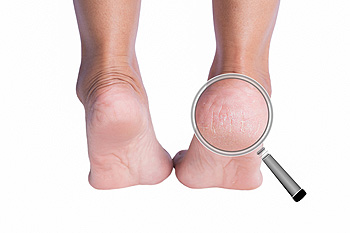
Cracked heels develop when skin on the heels is first allowed to become dry. It can then thicken and harden. This callused skin is more prone to cracking when the weight of the body bears down on the skin, causing it to break. It is important to keep the skin on your feet hydrated and healthy. Avoid wearing open-backed shoes that expose your heels to the elements. Staying in the water for too long can actually dry your skin out, so limit showers and baths to 5-10 minutes. Use gentle cleansers that don’t strip your skin from natural oils. Lock in moisture right after bathing by applying foot cream with alpha hydroxy acid or salicylic acid. Moisturizing your feet at night and covering them with socks while you sleep can also help heal cracked heels. However, those who are elderly or have diabetes should not try to treat cracked heels at home. These individuals, as well as those whose cracked heels have not improved with home treatment, should seek the professional care of a chiropodist.
Cracked heels, also known as heel fissures, can cause pain and discomfort. If your cracked heels are bothering you, please consult with Chiropodist Stephanie Poupore from North Bay Foot & Ankle. Our clinician will assess your condition and provide you with quality foot and ankle treatment.
Dry, thickened skin around the rim of the heel is typically the first sign of cracked heels. While this condition is common and usually just a nuisance, some cases can be more severe. If left untreated and as more pressure is placed on the heel, the cracks become deeper and eventually walking and standing can be painful. These deep cracks or fissures can bleed and also become infected. Those with diabetes need to be especially careful as fissures could lead to diabetic foot ulcers.
Causes
Cracked heels can be the result of several different factors, including:
-
Dry skin
-
Taking long, hot showers or using harsh soaps
-
Standing for long periods of time
-
Walking barefoot
-
Walking in shoes with an open back, such as sandals or flip flops
-
Wearing shoes that do not fit properly
-
Living in a cold or dry climate
-
Certain skin conditions, such as eczema or psoriasis
Treatment
There are many at-home treatment remedies for cracked heels. Applying moisturizers to the heel can help hydrate the skin. Soaking your feet in warm water and exfoliating them with a loofah or pumice stone can help to buff away dead skin cells. If you are afflicted with cracked heels, it is recommended that you see a chiropodist for treatment.
Prevention
You can prevent cracked heels by:
-
Avoiding standing in one position for prolonged periods of time
-
Wearing well-fitted shoes with a closed back
-
Washing your feet with gentle soaps and lukewarm water
-
Moisturizing the feet daily
If you have any questions, please feel free to contact our office located in . We offer the newest diagnostic and treatment technologies for all your foot care needs.
